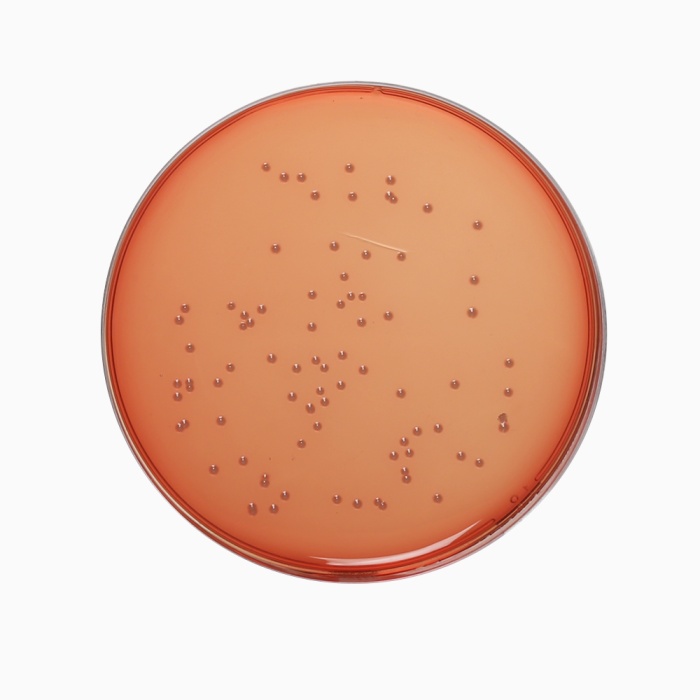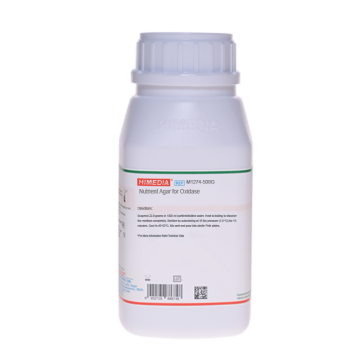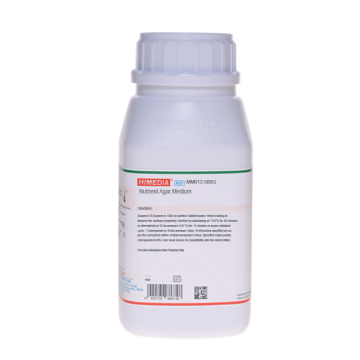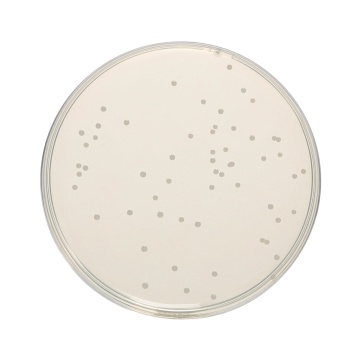 Your enquiry has been submitted
Your enquiry has been submitted
Nutrient Agar w/ 1% Peptone
Fastidious & Non-fastidious organisms#CC293D
Intended use
General purpose culture media which may be used as enriched medium by incorporating blood or other biological fluid.
Composition
| Ingredients | g/L |
|---|---|
| Peptone | 10.000 |
| Sodium chloride | 5.000 |
| HM Peptone B | 5.000 |
| Agar | 15.000 |
Final pH (at 25°C): 7.4±0.2
**Formula adjusted, standardized to suit performance parameters #- Equivalent to Beef extract
Directions
Suspend 35.0 grams in 1000 ml purified/distilled water. Heat to boiling to dissolve the medium completely. Sterilize by autoclaving at 15 lbs pressure (121°C) for 15 minutes. Cool to 45-50°C. Mix well and pour into sterile Petri plates.
Principle And Interpretation
Nutrient Agar with 1% Peptone has almost double concentration of the nitrogen sources than that used in Nutrient Agar, making it more nutritive. Nutrient media are basic culture media used for maintaining microorganisms, cultivating fastidious organisms by enriching with serum or blood and are also used for purity checking prior to biochemical or serological testing (1,2,3). It is one of the several non-selective media useful in routine cultivation of microorganisms (4,5). HM Peptone B and peptone provide the necessary nitrogen compounds, carbon, vitamins and also some trace ingredients to non-fastidious organisms like Bacillus subtilis and Staphylococcus aureus. Sodium chloride maintains osmotic equilibrium of the medium. With the addition of 10% v/v blood or other biological fluids like ascitic fluid, serum etc., this media is recommended for growing fastidious organisms.
Type of specimen
Clinical samples -urine, faeces,etc. ; Food and dairy samples; Water samples
Specimen Collection and Handling
For clinical samples follow appropriate techniques for handling specimens as per established guidelines(6,7).
For food and dairy samples, follow appropriate techniques for sample collection and processing as per guidelines (4,5,8). For water samples, follow appropriate techniques for sample collection, processing as per guidelines and local standards(9). After use, contaminated materials must be sterilized by autoclaving before discarding.
Warning and Precautions
In Vitro diagnostic use. For professional use only. Read the label before opening the container. Wear protective gloves/protective clothing/eye protection/face protection. Follow good microbiological lab practices while handling specimens and culture. Standard precautions as per established guidelines should be followed while handling clinical specimens. Safety guidelines may be referred in individual safety data sheets.
Limitations
- Individual organisms differ in their growth requirement and may show variable growth patterns on the medium.
- Each lot of the medium has been tested for the organisms specified on the COA. It is recommended to users to validate the medium for any specific microorganism other than mentioned in the COA based on the user's unique requirement.
- Further serological and biochemical characteristics are to be carried on pure isolated colony for complete identification.
Performance and Evaluation
Performance of the medium is expected when used as per the direction on the label within the expiry period when stored at recommended temperature.
Quality Control
Appearance: Cream to yellow homogeneous free flowing powder
Gelling: Firm, comparable with 1.5% Agar gel
Colour and Clarity of prepared medium: Basal medium: Light yellow coloured clear to slightly opalescent gel. After addition of 5%v/v sterile defibrinated blood : Cherry red coloured opaque gel forms in Petri plates
Reaction: Reaction of 3.5% w/v aqueous solution at 25°C. pH: 7.4±0.2
pH: 7.20-7.60
Cultural Response: Cultural characteristics observed with added 5% v/v sterile defibrinated blood, after an incubation at 35-37°C for 18-48 hours.
| Organism | Inoculum (CFU) | Growth | Recovery | Growth w/ Blood | Recovery w/ Blood | Haemolysis |
|---|---|---|---|---|---|---|
| Neisseria meningitidis ATCC 13090 | 50-100 | good | 50-70% | luxuriant | >=70% | none |
| Staphylococcus aureus subsp.aureus ATCC 25923 (00034*) | 50-100 | luxuriant | >=70% | luxuriant | >=70% | beta |
| Streptococcus pneumoniae ATCC 6303 | 50-100 | good | 50-70% | luxuriant | >=70% | alpha |
| Streptococcus pyogenes ATCC 19615 | 50-100 | good | 50-70% | luxuriant | >=70% | beta |
| Staphylococcus aureus subsp.aureus ATCC 6538 (00032*) | 50-100 | luxuriant | >=70% | luxuriant | >=70% | beta |
Key: (*) Corresponding WDCM numbers.
Storage and Shelf Life
Store between 10-30°C in a tightly closed container and the prepared medium at 20-30°C. Use before expiry date on the label. On opening, product should be properly stored dry, after tightly capping the bottle in order to prevent lump formation due to the hygroscopic nature of the product. Improper storage of the product may lead to lump formation. Store in dry ventilated area protected from extremes of temperature and sources of ignition. Seal the container tightly after use. Product performance is best if used within stated expiry period.
Disposal
User must ensure safe disposal by autoclaving and/or incineration of used or unusable preparations of this product. Follow established laboratory procedures in disposing of infectious materials and material that comes into contact with clinical sample must be decontaminated and disposed of in accordance with current laboratory techniques (6,7).
Reference
- Lapage S., Shelton J. and Mitchell T., 1970, Methods in Microbiology', Norris J. and Ribbons D., (Eds.), Vol. 3A, Academic Press, London.
- MacFaddin J. F., 1985, Media for Isolation-Cultivation-Identification-Maintenance of Medical Bacteria, Vol. 1, Williams and Wilkins, Baltimore.
- MacFaddin J. F., 2000, Biochemical Tests for Identification of Medical Bacteria, 3rd Ed., Lippincott, Williams and Wilkins, Baltimore.
- American Public Health Association, Standard Methods for the Examination of Dairy Products, 1978, 14th Ed., Washington D.C.
- Salfinger Y., and Tortorello M.L., 2015, Compendium of Methods for the Microbiological Examination of Foods, 5th Ed., American Public Health Association, Washington, D.C.
- Isenberg, H.D. Clinical Microbiology Procedures Handbook 2nd Edition.
- Jorgensen, J.H., Pfaller, M.A., Carroll, K.C., Funke, G., Landry, M.L., Richter, S.S and Warnock., D.W. (2015) Manual of Clinical Microbiology, 11th Edition. Vol. 1.
- Wehr H. M. and Frank J. H., 2004, Standard Methods for the Microbiological Examination of Dairy Products, 17th Ed., APHA Inc., Washington, D.C.
- Lipps WC, Braun-Howland EB, Baxter TE,eds. Standard methods for the Examination of Water and Wastewater, 24th ed. Washington DC:APHA Press; 2023.
| Product Name | Nutrient Agar w/ 1% Peptone |
|---|---|
| SKU | M012 |
| Product Type | Regular |
| Physical Form | Powder |
| Origin | Animal |
| Packaging type | HDPE |
| References | 1.Lapage S., Shelton J. and Mitchell T., 1970, Methods in Microbiology, Norris J. and Ribbons D., (Eds.), Vol. 3A, AcademicPress, London. 2.MacFaddin J. F., 2000, Biochemical Tests for Identification of Medical Bacteria, 3rd Ed., Lippincott, Williams and Wilkins,Baltimore. 3.Downes F. P. and Ito K., (Ed.), 2001, Compendium of Methods for the Microbiological Examination of Foods, 4th Ed.,American Public Health Association, Washington, D.C. 4.American Public Health Association, Standard Methods for the Examination of Dairy Products, 1978, 14th Ed., WashingtonD.C. 5.MacFaddin J. F., 1985, Media for Isolation-Cultivation-Identification-Maintenance of Medical Bacteria, Vol. 1, Williamsand Wilkins, Baltimore |
| Customized Product Available | No |













